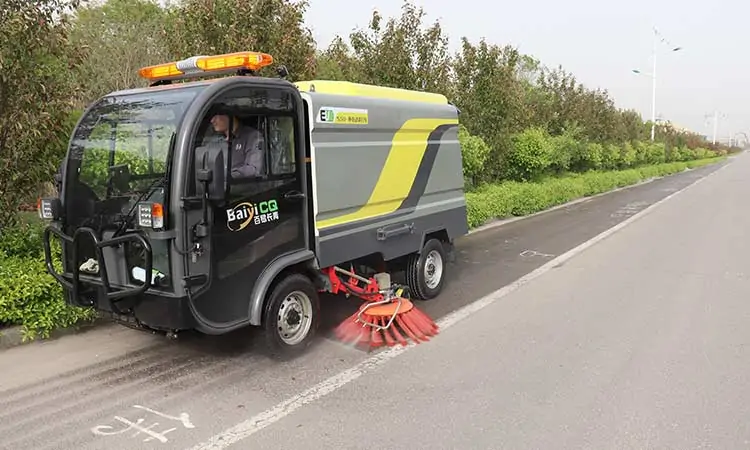
How To Judge The Battery Capacity Of An Electric Street Sweeper?
In the selection of sanitation cleaning electric sweepers, its endurance is a problem that people are more concerned about, and the level of endurance is related to the size of the battery capacity. So, how do we judge the size of the battery capacity? Below we will introduce this issue to you.
The rated capacity of the electric sweeper refers to the limit power that the battery should release under certain discharge conditions when the battery is manufactured, and the unit is Ah (Ah). The specified battery discharge conditions include: the discharge current of the battery is generally the discharge rate; the discharge termination voltage is different, the discharge current is also different; the discharge temperature, the discharge capacity of the battery is small when the battery is low temperature, and the discharge capacity is large when the temperature is high. In order to unify the discharge capacity, the discharge temperature was set.

The voltage that is discharged at 25°C to the point where it can be recharged repeatedly is called the end-of-discharge voltage. The discharge rate is different, and the discharge termination voltage is also different. Usually, the termination voltage of 10-hour discharge is mostly 1.8V/single cell, and the termination voltage of 2-hour discharge is generally 1.75V/single cell. Below this voltage, although a little more power can be released, it is easy to cause a decrease in recharge capacity, so it cannot be discharged below this voltage unless under special circumstances.
The discharge rate refers to the size of the discharge current of the battery, which is the time rate and the current rate, respectively. The discharge time rate refers to the time from discharge to termination voltage under certain discharge conditions. According to the IEC standard, the discharge rates are 20 hours, 10 hours, 5 hours, 3 hours, 2 hours, 1 hour, 0.5 hours, etc. As the battery discharges, the terminal voltage of the battery will gradually decrease.
Use C to represent the rated capacity of the battery. The battery capacity obtained by different discharge rates will be different. For example, the current value represented by the 10-hour discharge current is: I10=C10/10=0.1C10, and the 2-hour discharge current represents The current value is:
I2=C2/2=0.5C2, the discharge current of 1 hour discharge rate indicates that the current value is:
The above is a summary of the method of judging the battery capacity of the electric sweeper. Hope to bring you some hints and help.

How To Judge The Battery Capacity Of An Electric Street Sweeper?
In the selection of sanitation cleaning electric sweepers, its endurance is a problem that people are more concerned about, and the level of endurance is related to the size of the battery capacity. So, how do we judge the size of the battery capacity? Below we will introduce this issue to you.
The rated capacity of the electric sweeper refers to the limit power that the battery should release under certain discharge conditions when the battery is manufactured, and the unit is Ah (Ah). The specified battery discharge conditions include: the discharge current of the battery is generally the discharge rate; the discharge termination voltage is different, the discharge current is also different; the discharge temperature, the discharge capacity of the battery is small when the battery is low temperature, and the discharge capacity is large when the temperature is high. In order to unify the discharge capacity, the discharge temperature was set.

The voltage that is discharged at 25°C to the point where it can be recharged repeatedly is called the end-of-discharge voltage. The discharge rate is different, and the discharge termination voltage is also different. Usually, the termination voltage of 10-hour discharge is mostly 1.8V/single cell, and the termination voltage of 2-hour discharge is generally 1.75V/single cell. Below this voltage, although a little more power can be released, it is easy to cause a decrease in recharge capacity, so it cannot be discharged below this voltage unless under special circumstances.
The discharge rate refers to the size of the discharge current of the battery, which is the time rate and the current rate, respectively. The discharge time rate refers to the time from discharge to termination voltage under certain discharge conditions. According to the IEC standard, the discharge rates are 20 hours, 10 hours, 5 hours, 3 hours, 2 hours, 1 hour, 0.5 hours, etc. As the battery discharges, the terminal voltage of the battery will gradually decrease.
Use C to represent the rated capacity of the battery. The battery capacity obtained by different discharge rates will be different. For example, the current value represented by the 10-hour discharge current is: I10=C10/10=0.1C10, and the 2-hour discharge current represents The current value is:
I2=C2/2=0.5C2, the discharge current of 1 hour discharge rate indicates that the current value is:
The above is a summary of the method of judging the battery capacity of the electric sweeper. Hope to bring you some hints and help.

























 Home
Home About Us
About Us Product
Product After sales
After sales Contact Us
Contact Us